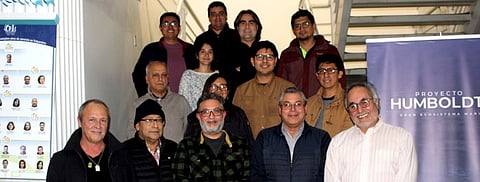

This project is part of the PNUD-GEF Humboldt II Project, led by the Undersecretariat of Fisheries and Aquaculture (Subpesca) and the Ministry of Production of Peru.
Subpesca
Experts from the Fisheries Development Institute of Chile (IFOP) and the Marine Institute of Peru (IMARPE) have gathered to advance the joint estimation of the biomass of the shared anchovy stock (Engraulis ringens) in southern Peru and northern Chile (SPNCH).
This process is carried out using the hydroacoustic method as part of the PNUD-GEF Humboldt II Project, led by the Undersecretariat of Fisheries and Aquaculture (Subpesca) and the Ministry of Production of Peru.
The hydroacoustic method is a non-invasive scientific technique that uses sound waves emitted from echo sounders installed on specialized vessels to obtain precise data on the available biomass.
Both countries monitor and exchange information to improve the understanding of marine population dynamics and strengthen decision-making in fisheries management.
"We have analyzed various biological aspects, sampling design, and methodological approaches used to ultimately obtain results that are useful for stock modeling," said Jorge Castillo, researcher at IFOP.
Additionally, the Peruvian researchers visited the scientific vessel Abate Molina, which was in Valparaíso preparing to set sail for the investigation of common hake. This vessel has been expanded and its facilities upgraded for the comfort of the researchers participating in the scientific cruises.
In November 2024, representatives from both countries met on the occasion of World Fisheries Day to discuss their cultural, social, and economic relationships surrounding the fishing industry.
